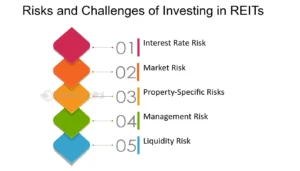What is Money 6x REIT Holdings?

Money Holdings is a specific kind of REIT that utilizes a leveraged strategy for investing to increase the potential return of real estate investments.
The basic concept is that Money 6x REITs make use of an amalgamation of debt and equity to purchase and keep property, with the aim to generate as much as the equivalent of six times (6x) of the revenue as conventional REITs.
Key Features of Money 6x REIT Holdings
The following are some of the features that might include, should that such a product does exist:
1. Focus on REITs (Real Estate Investment Trusts)
Reit Exposure: The fund, or plan would invest principally into REITs that are businesses which own, manage, or invest in income-generating real estate. This could include commercial real estate (e.g. office buildings and shopping centers) as well as residential complexes and industrial buildings, healthcare facilities and specific real property assets (like warehouses or data centers).
Diversification: REITs typically give investors exposure to various areas of real estate. They offer investors an array of exposure to the real estate market.
2. Leveraged Strategy (6x)
6x Leverage: It is important to note that the “6x” in the name could indicate leveraged strategies in which the fund utilizes loans or other financial instruments in order to boost potential gains (and risk) of the investments. A leverage of 6x is that for every dollar invested in equity by the investor the fund takes out another six dollars in order for REITs, or associated assets.
If, for instance, an investor makes a contribution of $100,000, the fund may take out a loan of $600,000 that would mean $700,000. investments.
The leverage can increase the chance to earn higher profits, however it also raises the possibility of losing money if the market is not moving in a favorable direction.
3. High Yield Focus
Income Generating: REITs are famous as having attractive dividends that makes them a favorite for people who seek income. Funds like “Money 6x REIT Holdings” is likely to focus on earning the highest yield through this type of investment, possibly choosing REITs with significant dividend payouts.
Distribution strategy: The fund could frequently distribute dividends to investors through dividends from income-generating real estate properties that are owned by REITs.
4. Aggressive Growth Strategy
Capital Appreciation: Alongside its income-focused goal, the fund could be aiming for an appreciation in capital through investing in REITs that have a strong potential for growth within sectors such as technology (e.g. data centers, etc.) or healthcare (e.g. medical office structures) as well as industrial (e.g. warehouses to support online shopping).
Possibility of High Returns: Because of the leverage used (6x) The fund’s strategies could be tailored to attract investors who want higher returns than average generally through investing in high-growth REITs that are high risk.
5. Risk Profile
Risky: The usage of leverage (6x) dramatically raises the risk that the funds face. If the worth of the REITs that are the foundation of the fund decreases, then the fund won’t just be unable to make money from its equity but remains in charge of servicing debt that could result in greater loss.
Market sensitivities: Due to the fact that it relies on leveraged investments this fund will be very sensitive to changes of interest rates (which impact the borrowing cost) and market cycles for property, and the performance of the real estate industry.
6. Target Audience
Advanced Investors: The leveraged REIT fund will likely target high-end or institutional investors who can handle greater risk,
For example investors who want to earn higher yields in exchange for a willingness to take the possibility of losses and volatility.
Potential for large-scale investment: Utilizing leverage implies that the fund could be attractive to investors who want to make big-scale investments in real estate, without the need directly buy physical properties.
7. Diversification in the REIT Sector
Sector Diversification: This type of fund could invest in a variety of areas of real estate like:
-
- Commercial real estate (e.g., office buildings, shopping centers)
- Residential real estate (e.g., apartments, rental properties)
- Specialty real estate (e.g., healthcare facilities, data centers, industrial properties)
Geographic Diversification: The fund could invest in REITs of various countries or regions to provide geographic diversification.
8. Fee Structure
Management Fees: Due to the complex and involved management in leveraged funds the management costs could be greater than normal REIT investments, notably when the fund uses proactive strategies to pick and oversee the REITs.
Performance fees: If the fund structure is as a hedge funds or actively-managed investment vehicle it could charge a performance fee in relation to the amount of returns it earns above a threshold rate or benchmark.
Benefits of Investing in REIT Holdings

The investment into REIT Holdings (Real Estate Investment Trusts) has several advantages particularly for investors looking for a way to diversify portfolios, earn an income or be exposed to real estate, without the need direct control of properties.
Below are a few of the most significant advantages to the REIT investment:
1. Regular Income from Dividends
High dividend yields: REITs are renowned as having attractive dividend yields that are often more than other kinds of investment options, like bonds or stocks. As per laws, REITs must to pay out at least 90% of its tax-deductible profits to shareholders in way of dividends.
Steady cash flow: The reason that a lot of REITs are invested in properties that generate income (e.g. office buildings or shopping malls) They generate regular rental income which will be distributed to investors through dividends. This is what makes REITs extremely popular among investors looking to earn income.
2. Diversification
Exposure to real Estate: REITs are the opportunity to make investments in real estate, without the hassle in managing physical property. They can help you diversify your portfolio among various areas of real estate, such as residential, commercial, industrial and health care property.
Geographic Diversification: A lot of REITs invest in different areas as well as globally, allowing geographic diversification. This helps reduce the chance of being exposed too much to one particular market or region.
Reducing Single Asset Risk: REITs own an array of properties that spreads risk. If one property is underperforming or is facing challenges (e.g. the property is vacant or has decreasing rent) then the impact for the REIT can be diminished through the performance of other properties in the portfolio.
3. Liquidity
Publicly traded REITs: The majority of REITs are listed on the major market exchanges (like the NYSE or NASDAQ) and are therefore very liquid when compared with physical property investments. Investors have the option of buying and selling REIT shares like stocks, which allows for a variety of options as well as ease of entry and out.
Market Price: Because REITs trade on public markets, their values are continuously updated according to market conditions. This provides greater visibility in the pricing.
4. Professional Management
Expertly-trained managers: REITs are run by experienced teams that have expertise in the field of real estate investment and leasing, management of properties, and acquisitions. Investors benefit by the expertise and knowledge of the real estate experts in charge of day-today operations which eases the burden for individuals who invest.
Effective Property Management: The teams of management of REITs generally have solid connections with their tenants, contractors and property owners, which could result in better administration and upkeep of properties, which can result in higher returns.
5. Access to Institutional-Grade Real Estate
Scale and high quality REITs usually invest in institutional grade, large-scale property that individuals may be unable to access like commercial offices, shopping centers industrial warehouses and health facilities. These properties may provide better return on investment and have better durability than smaller property.
Diversified property types A lot of REITs invest in a range of different types of properties or industries (e.g. data centers and medical office building, hotels for example.) which gives them access to niche property markets where individual investors might lack the funds to directly invest in.
6. Tax Advantages
Pass-Through Entity Model REITs have tax advantages due to the fact that they’re generally organized as pass-through companies. That means they’re non-affected by corporate income tax provided they pay minimum 90% of their tax-deductible income to shareholders as dividends. This will result in greater tax efficiency when compared with different types of businesses.
Possibility of Tax-Deferred Income Certain situations, REIT dividends can be tax-deferred under some retirement accounts, for instance IRAs as well as 401(k)s and 401(k)s, further increasing their tax-savings to long-term investors.
7. Hedge Against Inflation
Real estate as a hedge against inflation It is commonly thought of as to be a great hedge against the rise of the effects of inflation. With inflation rising and the price of real estate properties generally rises while rental income typically changes to match rising inflation. These REITs can be particularly appealing in times of increasing prices since they offer investors with income growth as well as the potential for increase in value of assets.
8. Capital Appreciation
Properties Value Appreciation Additionally the dividends they pay out REITs may also profit in an appreciation in capital as the property they invest in gain value over the course of. This is the case especially in the case of REITs that invest in fast-growing industries, like industrial real property (e.g. warehouses and warehouses to support eCommerce) or healthcare facilities and residential property in highly-demand locations.
Long-Term Growth Possibilities A lot of REITs concentrate on long-term property ownership as well as expansion, which allows investors to gain an appreciation and income in the long run.
9. Low Minimum Investment
Accessibility REITs can be accessed to investors who have relatively small investment minimums especially if they’re acquired via Exchange-traded Funds (ETFs) and mutual funds. This can make it simpler for small investors to get exposure to the market for real estate without requiring large sums of capital.
10. Transparency and Regulation
Restricted Industry: REITs are closely regulated by government agencies (in the U.S., for example for example, the Securities and Exchange Commission (SEC) as well as IRS). IRS). They are required to adhere to stringent reporting regulations, which could offer investors more transparency in their financial health as well as their property portfolios and their strategies.
Public Disclosure Reit companies that are publicly traded REITs must provide regular updates, which include quarterly results, allowing investors to evaluate their performance and make educated decision.
Risks of REIT Holdings

Although the REIT Holdings (Real Estate Investment Trusts) have a range of advantages, they carry certain risk. It is important to understand these risks for investors in making an informed decision. Below are the major risks involved when investing in REITs
1. Market Risk
Volatility: like other securities that are traded on the market REITs also are susceptible to market volatility. The value of REIT shares may be affected by factors such as the mood of investors, economic conditions as well as general market trends. So, REITs may be subject to price fluctuations even though the properties that they are based on remain solid.
Stock Market Correlation: REITs provide the opportunity to invest in real estate however, they’re sold as stocks, so they can have a correlation to the general market trends. In the case of a market recession or sell-off can negatively influence the price of REITs regardless how well the real estate assets that are underpinning them.
2. Interest Rate Risk
The Sensitivity of Interest Rates: REITs are known to be sensitive to fluctuations of interest rates. If interest rates increase the cost of borrowing increases and can adversely impact the REIT’s earnings, specifically when they are heavily dependent upon debt-financed financing. In addition, rising interest rates could cause REIT dividends less appealing with other fixed-income investment options like bonds, which can lead to an increase in REIT shares prices.
Higher debt cost: Most REITs make use of large quantities of credit (leverage) to finance investments in property and operation. When interest rates increase then the price for servicing debt rises this can impact the dividends and profits.
3. Liquidity Risk
Public Vs. Private REITs: The publicly traded REITs are fairly liquid as they are traded on exchanges that have major liquidity and can therefore be sold and purchased quickly. But, private REITs as well as non-traded REITs are not able to enjoy the same level of liquidity.
If you choose to invest in private REITs, you aren’t many options to sell shares. You could also be subject to penalties or delay in selling your shares.
Trade Volume: Certain lesser-known or smaller REITs with public trading, a the lack of trading volume can cause more spreads on bids-asks, and problems when selling or buying large amounts of shares, without impacting the value.
4. Property Market Risk
Real Estate Market Fluctuations: REITs are highly linked to the overall performance of the market for real estate.
If the demand for residential and commercial properties decreases the result could be less rental revenue, more vacant properties, and lower value of properties.
The decline in the real property market will directly affect the worth of REIT’s portfolio and the source of income.
Sector-specific risk: Certain REITs concentrate specifically on certain property areas (e.g. retail malls, office buildings as well as medical facilities, industrial property and so on.).
Any disruption or downturn in one particular industry (like the loss of brick and mortar retail, or the growth of remote working) could significantly affect the results of REITs that are specific to a sector.
In the same way, certain regions could be affected by economic declines which impact the properties within those regions.
5. Credit Risk
Tenant risk: REITs earn income mostly through rent from tenants. When tenants violate the lease agreement or do not pay rent on time, it could negatively impact the income of the REIT and impact its dividends and cash flow.
This could be especially problematic for REITs that have a high amount of tenants from vulnerable areas (e.g. retail, food or hotel).
The Risk of concentration REITs heavily concentrated within a particular client, industry or geographical area are at risk of the possibility of tenant defaults or recessions within this particular sector. As an example, suppose a REIT manages offices where many of the tenants come from the same sector (e.g. tech companies) and a decline within that sector could result in increased vacancy rates as well as a decrease in rental revenue.
6. Management and Operational Risks
Management risk Performance of a REIT is directly connected to the expertise and skills of the management team. Incorrect management choices including the overpayment for acquisitions, bad property management or inadequate capital allocation could negatively impact the performance of a REIT.
Costs and expenses REITs typically have management costs and costs that could reduce yields over the course of. Management fees that are high are a particular issue. They can drastically reduce net earnings or capital appreciation that investors earn. In addition, with non-public or private REITs, charges could be more opaque or difficult to determine.
How Does Money 6X REIT Holdings Work?
Money 6x REIT Holdings is a real property investment strategy that makes use of leverage to increase the potential return. The way it works is:
- Leverage: For each one dollar of your own funds you can borrow $5 which gives you an amount of $6 per one dollar invested.
- Diversification is a strategy that is to invest in a wide assortment of REITs including industrial, residential, commercial and infrastructure as well as hybrid REITs.
- The potential for higher returns: Leverage will significantly enhance returns if the market does very well.
- Higher buying power: Leverage permits investors to put money into an even larger amount of portfolio than the starting capital could allow.
- Risques: Although leverage is able to increase gains, it could cause losses to increase in the event of a market decline. There are also risks that are associated with fluctuations in interest rates and an increase in volatility.
How 6X REIT Holdings Generates Income

Money 6x REIT Holdings generates income through multiple sources, including:
- Rental income: The REITs in the portfolio have a variety of property, including commercial, residential, and industrial. These properties earn rental income from tenants.
- Lease payments: Leasing with long-term tenants can provide a regular flow of revenue.
- The Interest Earnings: Reits can invest in mortgages and real mortgages, and thus earn an interest rate on these investments.
- Property sales: Sometimes, the properties in the portfolio could be offered for sale at an income.
- Dividends: REITs are obliged to pay out at least 90% of its tax-deductible dividends to shareholders in form of dividends. This provides regular income for investors.
Strategies to Maximize the Returns of the 6X REIT Holdings

For the best returns from Money 6x REIT Holdings, take a look at these strategies:
- Search and Select high-performing REITs: Take your time evaluating and choose REITs that have good historical performance as well as solid financial health.
- Reinvest Dividends: Reinvesting dividends may boost your earnings over the course of time, which allows you to buy more shares and profit from growth in the future.
- Utilize leverage wisely: Utilize leverage in a strategic way to boost your return Be aware of the risks involved.
- Monitor and Balance Your Portfolio: Check your portfolio and make adjustments to make sure it is in line to your investment objectives and the market’s circumstances.
-
Stay informed about market trends: Follow market news and economic developments for informed decision-making and take advantage of opportunities.


